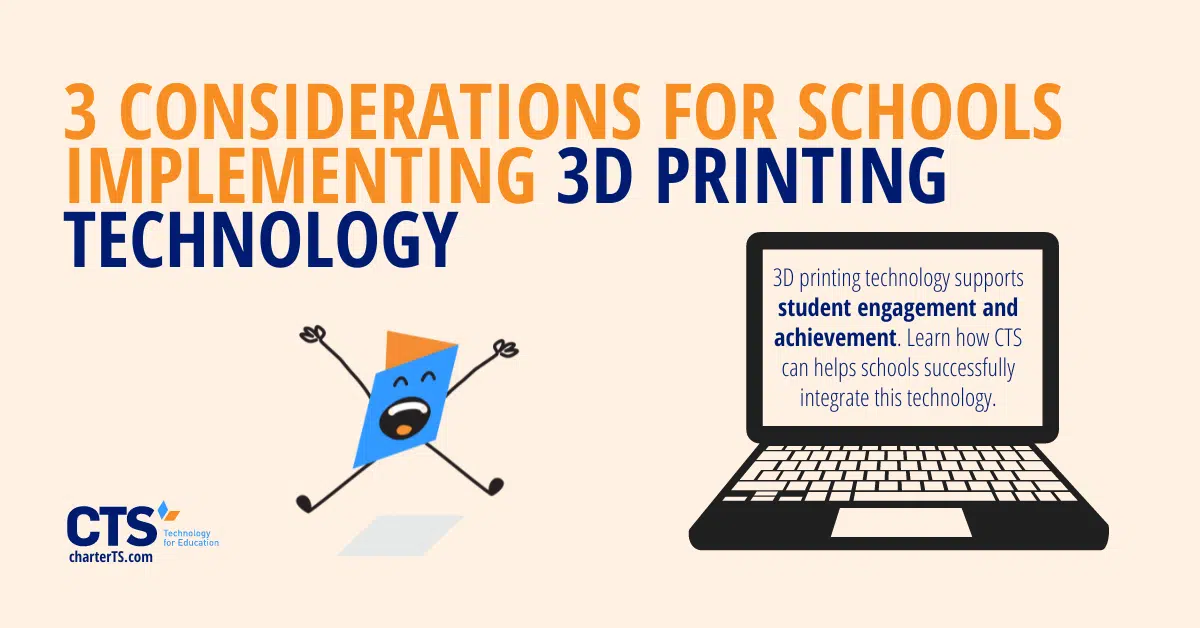As prices have decreased over time, 3D printing technology is finding its way into more classrooms.
3D printing technology creates three-dimensional objects from digital files by printing multiple layers of material. While plastic is still the most commonly used material, other raw materials – such as carbon fiber, metal, and graphite – are used as well. For decades now, this technology has been revolutionizing the manufacturing industry by reducing waste and enhancing efficiency. In the medical field, 3D printing is being used for designing surgical instruments, making custom-made prosthetics, and bioprinting tissue and organoids. In 2010, a 3D printer could cost a school or district around $15,000. Over the last several years, the lowering cost and wider availability of this incredible technology have made it so that these printers are more commonplace. With this reduction in price, schools can now take advantage of the learning experiences that 3D printers can offer students.
Schools looking to bring 3D printing technology to their students can start by considering these three questions:
First: Which of the many benefits of 3D printing are priorities for your teachers and students?
3D printing can support learning in a variety of ways and offers a whole host of benefits to students. For example, students can and have used 3D printers to create solar-powered motion-sensing alarms, to design and print nests for a unit on birds, to create 3D versions of their graphic designs, or to print models of molecules for chemistry class. The printers can also be used to teach students design thinking skills or as skill-building for a career in STEM. With these varying options for increasing student engagement, making the curriculum more hands-on, and providing students with workforce-aligned skills, there are many reasons why a school would choose to use this technology. Having a sense of the primary use of the printers can help school leaders decide which hardware and software align best with their priorities.
Second: Which 3D printer is the best printer for my school?
When it comes time to select a printer, schools want to select a printer that is reliable, simple to use, and comes with some educational resources. A reliable 3D printer is essential because teachers and school leaders don’t have a lot of time to spend trying to fix and troubleshoot a printer that never really works. It’s also incredibly frustrating for students and teachers alike to prepare and plan for an activity only to find out last minute that the printer is down.
3D printing will likely be new technology for many teachers and students, so selecting a user-friendly option can help make the learning curve more manageable. Elementary schools looking for 3D printers will likely want a more simple option for their students, while high schools can procure devices with greater sophistication and more features.
More and more manufacturers are creating printers that are compatible with student learning. These printers, with their school-focused offerings, are the best options for students and teachers because they come with a curriculum, interactive exercises, and lesson plans.
Finally: What training and support will I need to offer my teachers?
Understanding how to use the actual printer itself may be one learning curve for educators. Another learning curve can be figuring out how to successfully incorporate 3D printing activities into the overall arc of student learning. Online printing certification courses are available for teachers and some colleges and universities are also offering workshops for educators to build their technical and instructional skills. However, building a teacher’s capacity to successfully integrate 3D printing into their curriculum in a way that drives student engagement and achievement takes time. Schools that offer proactive, ongoing professional development teachers are more likely to have this resource used well.
At CTS, we support schools as they work to integrate new technology into the classroom.
3D printing technology has opened up a world of possibilities for fields like manufacturing, medicine, architecture, design, and now education. In schools, the use of this technology can drive student engagement, support students with varying learning styles, and prepare students for the future job market. Once school leaders are ready to bring 3D printing into their classrooms, there are time-intensive steps to source and procure the right printer for their school’s unique mission. This is where CTS can help.
We support schools with sourcing and procuring reliable and cost-effective 3D printing technology. We can handle the hardware and software purchasing; we can support staff with training so they can make good use of the technology in pursuit of better student engagement and increased achievement. If you are interested in learning more about the availability of emerging technology and how implementation can benefit your students, we can help. Contact us today to learn more about our services and how we can help your school accomplish its unique mission.




